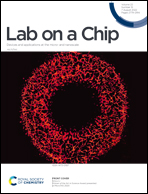A versatile optofluidic microreactor for artificial photosynthesis induced coenzyme regeneration and l-glutamate synthesis†
Abstract
With the rapid development of modern society, the energy crisis has become a global concern. Solar energy is a good replacement because it is green, unlimited and environment-friendly. Inspired by natural photosynthesis, artificial photosynthesis was developed to convert solar energy to chemical energy by a photocatalyst system. For better utilizing solar energy and improving the conversion efficiency, the design of photoreactors is crucial for the improvement of photocatalysis efficiency. However, most of the reported microreactors hardly satisfy the demands for low cost, easy fabrication, high transparency, being evaporation-proof, ease of scaling up, high surface-to-volume ratio, and photocatalyst immobilization. In this paper, we developed a facile method to build a fully immobilized microreactor (FIM) and a controllable partially immobilized microreactor (PIM), both of which satisfy all the demands mentioned above. In the FIM, the regeneration rate of a coenzyme (nicotinamide adenine dinucleotide, NADH) reached 82.20% in 40 min. Considering the NADH regeneration rate per unit/coating angle of photocatalysts in circular microreactors, the PIM performed much better than the FIM, proving that our partial coating method is a significant and useful improvement. Also, the bioactivity of NADH toward enzyme catalysis was demonstrated by glutamate dehydrogenase-catalyzed synthesis of L-glutamate, and the conversion of α-ketoglutarate reached 99.92%. To test the practicality of the microreactor in a real environment, we performed a test under solar light, achieving a good result of 74.92% in 60 min. Thus, this efficient and versatile microfluidic platform may have good potential for photocatalytic synthesis of versatile valuable products in the future.



 Please wait while we load your content...
Please wait while we load your content...